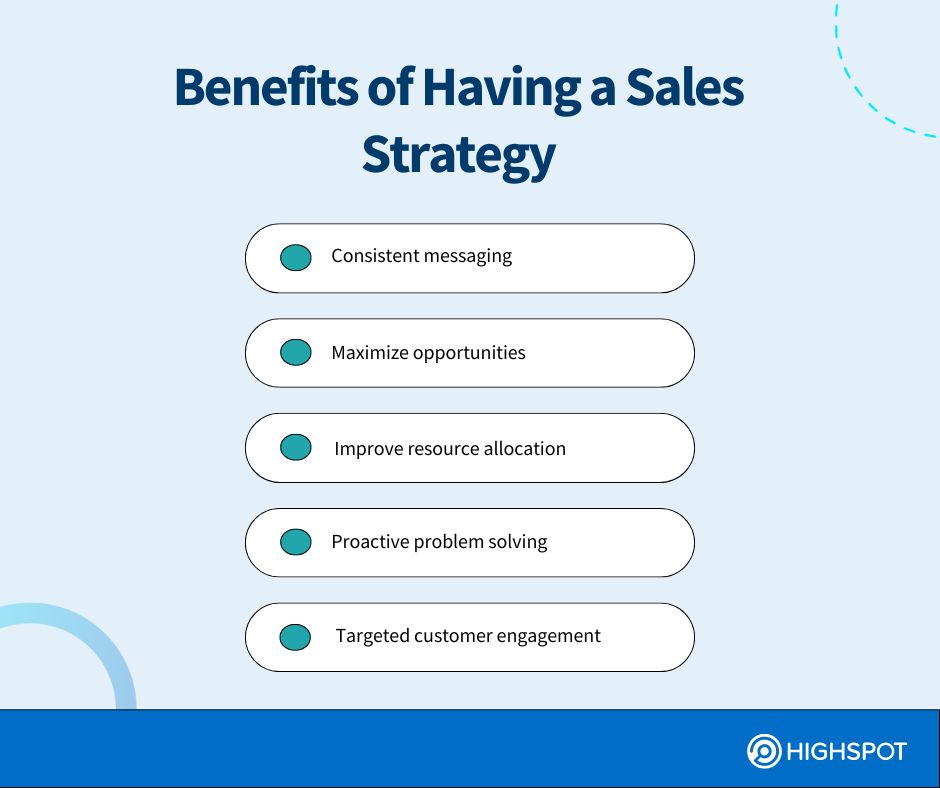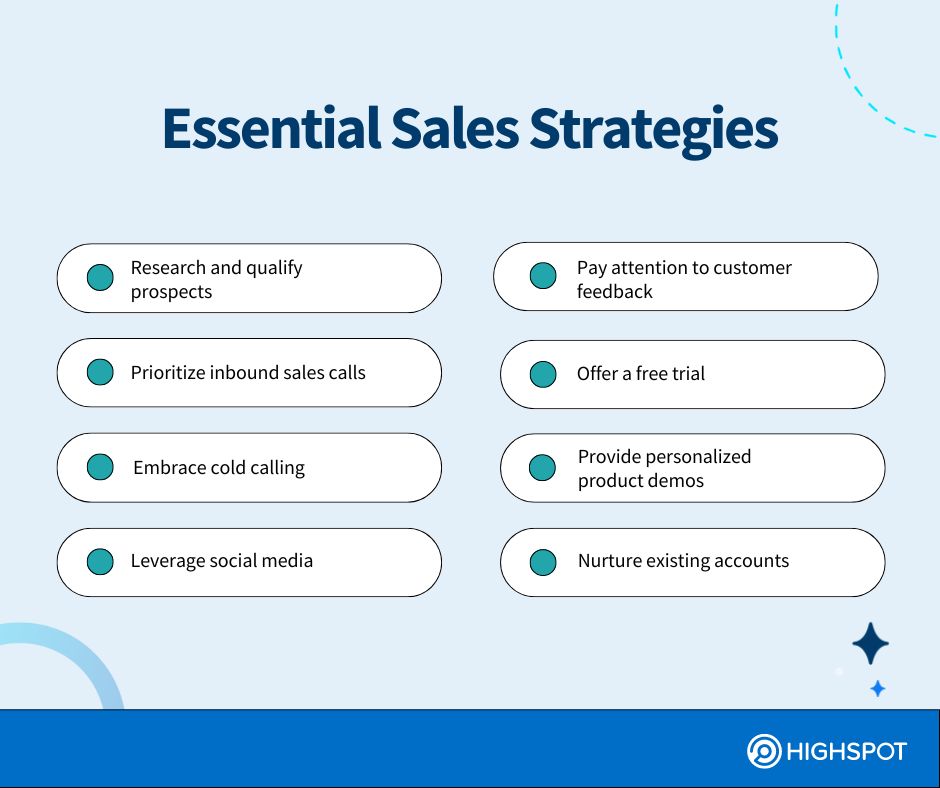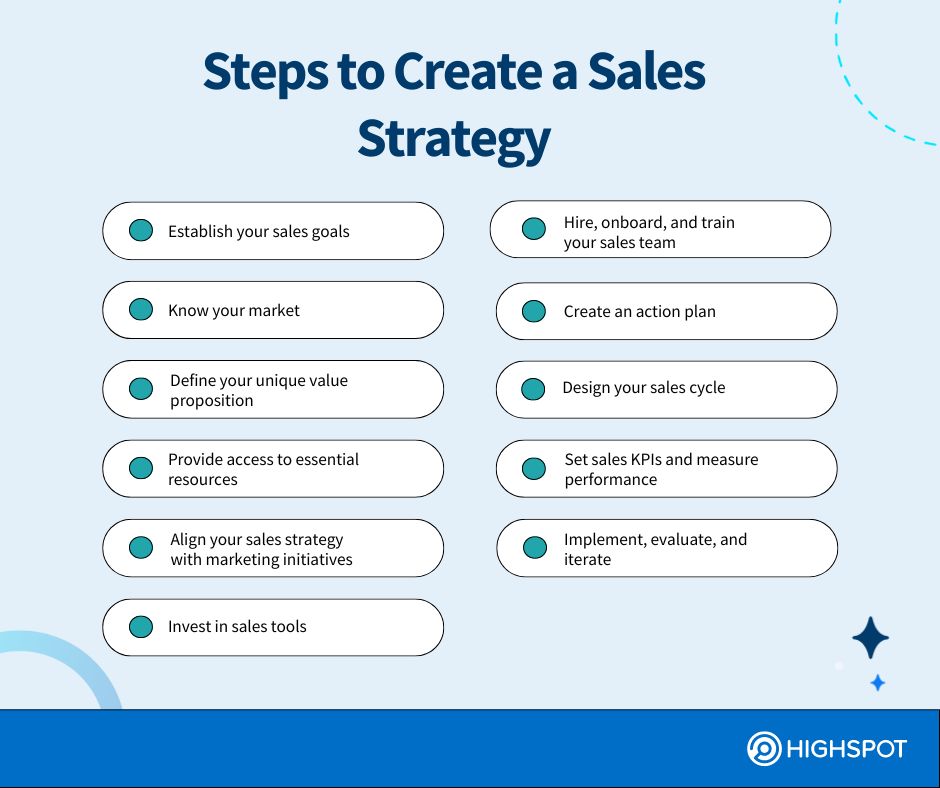Did you know that 40% of sales representatives fail to meet their quotas? The sales rep’s job is tough and has become even more complex over the past two years. In fact, 81% of CROs report that their team’s deals are significantly more complicated. Opportunities take longer to close, average deal sizes are declining, and new customer wins are few and far between.
What’s the secret to easing the burden on sales reps while helping them deliver value and meet their quotas? According to Jill Konrath, a renowned sales strategist, sales reps need strategies and resources to offer value at every customer interaction.
Keep reading to discover proven sales strategies, real-world examples, and actionable sales tactics that will help your team work smarter and close more deals.
What Is a Sales Strategy?
A sales strategy guides your sales reps in positioning your company and products to attract and secure new customers. It includes clear directives on sales processes, product positioning, methodologies, and competitive analysis, which help you achieve your sales goals.
Building lasting customer relationships is at the heart of a structured sales strategy. Open customer communication and trust can significantly impact brand loyalty and customer satisfaction. Any company, large or small, needs to revisit its sales strategies regularly to adapt to new market trends, newly surfaced business goals, and shifting customer needs.
Download Now: Five Ways to Modernize Your Sales Strategy
Importance of Having a Sales Strategy
An effective sales strategy is like giving your sellers the best roadmap. It will lead to better team performance, precise targeting, and more closed deals.
Here’s why a sales strategy is a game-changer for businesses:

- Consistent messaging: Imagine everyone in your team speaking the same language when talking to customers. A solid sales strategy ensures that happens. It keeps all your communications consistent, which not only builds trust but also strengthens your brand identity.
- Maximizing opportunities: With a clear strategy, team members can spot opportunities faster and prioritize more accurately, tailoring their conversations to turn prospects into happy customers.
- Improved resource allocation: A good strategy keeps your sales team from wasting time guessing. By focusing your time and money where it counts, you optimize team efforts and boost your return on investment.
- Proactive problem solving: Planning ahead with a sales strategy keeps you prepared. By anticipating problems before they pop up, you’re not stuck fixing messes but smoothly steering clear of potential setbacks.
- Targeted customer engagement: Knowing your ideal customers and understanding their needs and industries helps you add more value during sales calls. A robust sales strategy allows your sales reps to customize their sales pitch to resonate perfectly with each customer, making their approach more engaging.
A well-planned sales strategy sets your entire revenue organization up for growth and ensures your business thrives in the long run. It’s about smarter planning today so you can be successful tomorrow.
Two Most Common Types of Sales Strategies
There are many sales strategies, but let’s set the stage with the well-known inbound and outbound sales strategies. Both are distinct in how they attract customer interest. Simply put, inbound draws customers to your brand naturally, while outbound is traditional sales outreach.
- Inbound sales strategy: Inbound sales strategies create a magnet that naturally attracts customers to your brand. You will create valuable content, optimize your website for search engines, send engaging emails, and remain active on social media. The idea is to make potential customers come to you with a brand so appealing that customers can’t help but want to learn more.
- Outbound sales strategy: On the other hand, outbound sales are more like going door-to-door. It involves contacting potential customers through cold calling and emailing methods. Think of it as the traditional sales approach, where you initiate the conversation rather than wait for customers to come to you.
Typically, a healthy mix of inbound and outbound strategies works best. For example, a software company might use inbound strategies like SEO tech blogs, how-to guides, and industry-related webinars to attract interest. At the same time, they might also use outbound sales activities like cold calling or LinkedIn messages to reach out directly to targeted business decision-makers. This blend allows companies to cover all bases by nurturing organic relationships and reaching out to those who may not know they have a problem or need a new solution.
| Inbound Strategy | Outbound Strategy |
|---|---|
| Customer finds you | You find customers |
| Natural lead nurturing | Sales pitching |
| Build relationships | Transactional |
| Customer knows your business/brand | The customer is unfamiliar with your business/brand |
| Content strategy | Cold calls and emails |
| Social community strategy | Banner and display ads |
| Subscription email marketing | Paid email lists |
Sales Methodologies that Fuel Your Sales Strategy
In addition to inbound and outbound selling, teams can mix and match selling methods as part of their broader strategy. Each sales methodology can become a powerful tool in your strategy toolkit. These methods include:
- Value-based selling: This method focuses on understanding and reinforcing the value that your product or service brings to a customer’s life or business.
- Consultative selling: This approach involves understanding the customer’s needs and tailoring your conversation appropriately. The goal is to become a trusted advisor through detailed questions and active listening.
- SPIN selling: SPIN stands for situation, problem, implication, need-payoff. This sales technique helps sales reps focus on asking the right questions at the right time. The goal is to uncover a customer’s fundamental needs and then naturally lead them to your solution.
- Solution selling: This method is all about solving a problem. Solution sellers identify potential customers’ pain points and customize their products or services to address them.
- Challenger selling: This approach challenges the customer’s thinking by offering additional value. It encourages sales reps to teach, tailor, and take control of sales conversations. Instead of echoing what prospective customers want to hear, challenger sellers present other perspectives that teach customers something rather than just selling a tool.
Sales reps and customers may respond differently to each method, so using various approaches helps connect with a wider range of customers across industry verticals and business sizes.
8 Proven Sales Strategies That Drive Results
There is no one-size-fits-all sales approach. Whether you’ve been selling for decades or are new to sales leadership and planning, implementing the right tactics can significantly improve your team’s performance and bottom line.
Let’s look at eight practical (and essential) sales strategies that apply to all sales teams:

1. Research and Qualify Prospects
Your prospects must meet qualification criteria (budget, timeline, company size, industry, or other parameters) before your sales reps engage with them for the first time. You want your sales efforts to be targeted and impactful, not wasted on uninterested leads that you can’t help.
A Gartner survey found that although 34% of marketing-qualified leads (MQLs) convert to sales-accepted leads (SALs), only 47% of these SALs evolve into sales-qualified leads (SQLs), with just over half ultimately closing as won deals. This underscores the need for marketing and sales qualification processes, which can accelerate conversion.
2. Prioritize Inbound Sales Calls
Inbound leads are ‘warmer.’ They have come to you without direct sales outreach. However, this doesn’t mean they are ready to buy, but prioritizing them can result in higher conversion rates because the prospect has already shown interest in your brand’s product or service.
3. Embrace Cold Calling
Cold calling is a necessary tool in sales that can open doors to new opportunities despite its reputation. Interestingly, a RAIN Group study found that 82% of buyers say they accept meetings, at least sometimes, with sellers who reach out to them proactively.
Always start your cold call with a concise and attention-grabbing introduction that highlights the value you offer. Clearly articulate how your product or service can fulfill the prospect’s needs or solve their pain points. The last thing you want to happen is to get caught off guard with objections, so be sure to prepare responses that address concerns without being defensive.
4. Leverage Social Media
Social selling has become a must-have branding and sales tool. It helps strengthen your brand, expand your reach, and attract high-quality leads. LinkedIn is a natural destination for sales reps to build relationships with prospects and position your business as a trusted expert. Approximately 78% of salespeople who use social media perform better than their peers.
5. Pay Attention to Customer Feedback
Listening is key to keeping your customers. Asking for feedback through surveys or other methods and adjusting your product or service accordingly shows you’re dedicated to customer satisfaction, leading to better quality solutions and services that attract new customers. Companies that adopt a customer feedback process often see lower churn rates and more opportunities for upselling and cross-selling.
6. Offer a Free Trial
No-obligation trials are one of the most effective sales strategies to attract new customers. They allow them to experience your product without risk. A trial is essential for costly products and may be guided or self-serve depending on product complexity.
7. Provide Personalized Product Demos
Showcasing your product’s value and functionality is incredibly persuasive, especially when you show how the solution solves a prospect’s problem. Demos must be available for complex or high-value products. 69% of consumers believe a product demo best assists them when making a purchase decision.
8. Nurture Existing Accounts
Nurturing existing accounts is always easier and more cost-effective than acquiring new ones. It can uncover upsell, cross-sell, and renewal opportunities. Some ways you can improve customer retention are to launch a rewards or referral program, provide early access to promotions, and offer VIP incentives and discounts.
11 Steps to Create a Successful Sales Strategy
It’s time to build a sales strategy that works. Start by setting clear sales goals and then work with sales leaders to identify what your sales team needs to do to reach those revenue targets. This typically involves:
- Understanding your target customers and their unique needs
- Developing messaging and communication approaches
- Equipping your team with the right tools and resources
- Implementing metrics to measure progress and success
Let’s outline 11 steps to create a sales strategy that provides your sales team with the knowledge, tools, and guidance to find and retain customers:

1. Establish Your Sales Goals
Start defining clear revenue and sales performance goals aligning with the company’s objectives. Once you have these goals, you can determine how your team will reach them and measure success along the way. Remember that a goal should be SMART — specific, measurable, achievable, realistic, and time-based.
For example, ‘Increase total revenue by 25% year-over-year by the end of this fiscal year’ is a SMART sales goal.
- Specific: It targets a 25% increase in total revenue.
- Measurable: Revenue numbers can be easily tracked and measured.
- Achievable: A 25% increase is ambitious yet attainable with the right strategies and effort.
- Relevant: Increasing revenue is a key objective for most businesses.
- Time-bound: It has a clear deadline of the end of the fiscal year.
Goals are a collaborative business effort. To set these goals, sales leaders should work with cross-departmental executives, managers, and other stakeholders. Evaluate past performance metrics, too. Ask questions like:
- “How much did my team sell last year?”
- “Which clients generated the most revenue?”
- “What’s the next logical step to increase sales?”
- “Which assets will my team need to support the next growth stage?”
Answering these questions will help map a path from your current position to your desired outcomes.
2. Know Your Market
Markets are constantly evolving—new competitors emerge, and customer preferences shift. That’s why research can’t be a one-off thing. You must stay updated to continuously refine your strategy, meet changing demands, and maintain that competitive edge.
Understand Your Target Audience
One of the most basic pieces of knowledge your business needs is who will buy what you’re selling. To develop a sales strategy , you must understand your target customers, including the nuances of their behaviors and preferences. Focus on preparing an ideal customer profile (ICP) and buyer personas.
Your ICP gives you a high-level overview. It defines the core segments you want to target based on characteristics like industry, company size, location, and demographics. Buyer personas then get more personal—detailed profiles of your typical customer. What are their goals and pain points? How do they tackle decision-making? What communication styles do they prefer?
To truly understand your customer base, collect feedback and do market research. Have conversations with your current customers. Ask what they love, what needs improvement, and why they chose you over others. This first-hand feedback is gold.
Research Your Competition
What other products are out there that offer similar value or solve similar problems? Be prepared to handle objections, whether it is an existing solution with similar value, a homegrown fix, or no solution at all. Assess your competition to identify potential advantages or gaps in your strategy.
Keep a close eye on your competitors. What are they doing well? Where could they improve? Learn from their successes and mistakes. Tools like social monitoring, newsletters, and competitive intelligence software can help you stay looped in on their moves.
3. Define Your Unique Value Proposition
Your unique value proposition (UVP) tells your customers why they should purchase your product by emphasizing its unique benefits. To define your UVP, identify how your solution stands out to solve problems or enhance the customer’s situation better than anyone else.
The value prop should be concise yet compelling, explaining why customers should choose your product over the alternatives. A well-crafted UVP attracts customers and anchors your sales and marketing team strategies, providing the foundation for a clear and consistent message across all channels.
4. Provide Access to Essential Resources: Messaging and Pricing
What core message will your sales reps lead with when pitching your product? Work closely with product marketing to ensure your sales team can easily access buyer personas, messaging, and accurate pricing. Make these foundational resources available, continuously refine them, and ensure sales reps know how to use them.
5. Align Your Sales Strategy with Marketing Initiatives
To avoid working in silos, closely align your sales strategy with marketing efforts. Regularly review and coordinate so that marketing activities—from content creation to lead generation—are designed to support and amplify your sales targets.
Implementing sales enablement technology can help synchronize these efforts. It provides a unified platform where sales teams can easily access marketing-approved resources. This alignment is key for attracting and converting new leads that fit your ICP.
6. Invest in Sales Tools
The right technology stack, from forecasting tools and data analytics to CRM systems and sales enablement platforms, can streamline operations and provide valuable insights. Today’s teams rely on sales enablement technology to better align marketing and sales.
A sales enablement platform creates a single source of truth for marketing content, sales plays, and templates. This allows sales reps to quickly find, customize, and pitch the latest approved assets.
Some enablement platforms are even integrating AI capabilities to empower sellers further. For example, an AI engine could analyze a rep’s emails and call transcripts to provide real-time coaching on message consistency, talk ratios, and areas for improvement. Research shows that 84% of businesses that use AI have seen an increase in sales by improving and speeding up customer interactions.
While powerful, these solutions’ success ultimately depends on a solid sales process and strategy. Bring marketing into the strategy development phase and provide ongoing feedback as you execute to boost your strategy’s impact.
7. Hire, Onboard, and Train Your Sales Team
Successful sales teams are well-educated about your product, market, and competition. Sales onboarding, training, and coaching programs will prepare your team for success. These programs should include practical exercises, access to sales enablement materials, and continuous learning opportunities to keep your team sharp and prepared.
Being an experienced sales rep is one thing. Understanding pragmatic product messaging, target markets, value propositions, ICPs, and competitive advantages is another. Organizations with a standard onboarding process experience 50% greater new-hire productivity.
Make sure your sales training includes:
- Onboarding and ramp-up for every new hire
- Overview of your sales technologies and how to use them
- Modules on accessing sales enablement materials
- Best practices for sales pitches and selling
Beyond this, sales managers should provide ongoing mentorship and coaching to help sales reps navigate and improve their sales calls, emails, and general selling skills. Use a robust sales training software to build:
- Just-in-time training
- On-demand learning videos for sales methodologies you use
- Routine practice sessions
- Performance evaluation and reporting
8. Create an Action Plan
How are you going to achieve your sales goals? Document in detail the tactics, responsibilities, and timelines for executing each element of your strategy. If you have a project management team, get them involved in deploying the new sales strategy; otherwise, create a sales strategy plan with tasks, responsible parties, and due dates.
9. Design Your Sales Cycle
Map out your entire sales cycle from initial contact to closing a deal. Tailor this process to fit your business model and customer buying behavior. Provide a consistent framework your sales team can follow to nurture leads into customers.
Socialize this process across stakeholders, including marketing. This ensures they can support the full customer journey with the right resources.
10. Set Sales KPIs and Measure Performance
Setting goals and measuring sales success starts with regularly reviewing sales performance data. Are measurements new to you, and are you unsure where to start? Begin by focusing on the sales metrics and KPIs you care about most. Ask yourself:
“What goals are we trying to achieve?”
“What metrics show if we’re getting there?”
Once you’ve defined your desired KPIs, ensure your sales enablement and CRM technologies have adequate reporting capabilities. Check out this article for a list of common sales performance metrics.
11. Implement, Evaluate, and Iterate
After rolling out your sales strategy, set a routine for continuous evaluation and iteration. Regular assessments help you stay responsive to market changes or shifts in your organization, such as a new competitor entering the market or tackling larger enterprise clients.
Use feedback and performance data to refine your strategy on an ongoing basis. By following these steps and continually improving your approach, you will develop a sales strategy that meets your current needs and is flexible enough to adapt to future challenges and opportunities.
Top Sales Strategy Examples to Learn From
With real-world data in mind, let’s explore examples from FedEx, Siemens, and Finastra to fuel your strategic planning. While these examples showcase proven strategies, the takeaway is crafting an approach tailored to your unique business needs.
Study these examples, but adapt the principles to fit your audience, product offerings, and growth expectations.
FedEx Office’s Digital Transformation
When buyer preferences shifted towards digital-first experiences, FedEx Office recognized the need to unify its tech stack. Even with a consistent CRM experience, sellers had a hard time using separate tools and got stuck with manual tasks, making it challenging to engage with buyers effectively. To address this problem, they implemented a sales enablement platform that could seamlessly integrate with their existing systems, like Salesforce.
FedEx’s strategic timing proved pivotal. Just as they started this initiative, the pandemic struck, accelerating the need for robust digital selling capabilities. With an intuitive platform and digital sales rooms (DSR), FedEx reps could instantly personalize and pitch engaging microsites, establishing thought leadership while improving buyer engagement by 22%.
Siemens’ Partner Enablement Journey
As Siemens transitioned to a SaaS model, aligning with their extensive partner ecosystem became critical. However, their existing HTML partner portal lacked usability, analytics, and a cohesive user experience, hindering partner productivity.
Siemens recognized this hurdle and implemented a solution to customize enablement journeys for diverse partner audiences worldwide. This allowed them to package complex information into digestible formats to support their sales strategies. Furthermore, their Expert Partner Program helped expert partners use their enablement content effectively and guide future experts on how they can achieve similar success. In turn, this improved partner productivity by 35% and annual growth targets by over 100%.
Finastra’s Sales and Marketing Synergy
This global FinTech company sought to drive efficiency, accuracy, and customization across its sales and marketing efforts. Their previous content management system struggled with version control and usage insights, creating misalignment.
Finastra found a way to integrate their existing systems, like SDR outreach, with a centralized sales content management system. They established a single source of truth for sales and marketing teams and optimized their sales content strategy with data-driven insights. As a result, their marketing-influenced sales pipeline increased by 50%.
Implementing and Improving Your Sales Strategy with Highspot
If you’re ready to experience a structure that leads to new levels of revenue growth, consider Highspot’s sales enablement platform to support your sales strategy. Highspot aligns your sales and marketing strategy, empowering your team with AI-powered enablement, training, coaching, and analytics.
Request a Highspot demo today.


